七年级英语下册Unit6I’mwatchingTV学案(新版)人教新目标版
七年级英语下册Unit6I’mwatchingTV知识点总结+导学案(无答案)(新版)人教

七年级英语下册Unit6I’mwatchingTV知识点总结+导学案(无答案)(新版)人教Unit 6 I’m watching TV.知识点总结归纳一、短语归纳1.read a newspaper = read newspapers 看报纸2.talk on the phone 打电话3. want to do sth. 想做某事/doc/0e7697213.html,e the computer 用电脑6.wash the dishes = do the dishes 洗盘子7.Not much=Nothing much 没什么事8.go to the movies 看电影9.eat out 出去吃饭10.drink tea 喝茶11.Dragon Boat Festival 端午节12.join sb for sth 与某人一起做某事13.any other 任何一个14.host family 寄住家庭15.wish to do 希望做某事16.the United States 美国17. boat races 龙舟比赛18.listen to a CD = listen to CDs听CD19.make soup 做汤 20. eat dinner吃晚饭21. wash the dishes 洗餐具=do the dishes22.read a story to sb. 读故事给某人听 23.in the pool 在游泳池24.be at home 在家 25. in the shop=in the store 在商店26.live with sb. in... 和某人一起住在27.would love to do =would like to do 乐意做…28.clean the house=do some cleaning 打扫房子29.make dinner做晚饭 30.go shopping 去购物31.go to the movies=go to see a film去看电影32.in the living room 在客厅 33.the Dragon Boat Festival 端午节34.in the supermarket 在超市35.in the library 在图书馆36. on the playground 在操场37. in the United States=in the US 在美国38. watch the boat race on TV 在电视上看龙舟比赛39.write a letter写一封信 40. thanks for sth. 为... ...而感谢41.a picture of my family 一张我家的照片42.host family 房东家43. read ... sb.读... ...给某人听44. want to do sth. 想做某事45.see you tomorrow 明天见46.swim in a pool 在游泳池里游泳47.make zongzi 包粽子 48. the night before 前一天夜里49. watch... on TV 在电视上看 ... ... 50. talk show 脱口秀二、用法集萃1. --What +be+主语+doing? ... ...正在做什么?--主语+be+doing sth. ... ... 正在做某事。
初中英语人教版七年级下册UNIT6 I’m watching TV.教学设计方案

教学设计方案UNIT6 I’m watching TV.SectionA 1a-1c教学目标:1、语言目标:通过学习让学生掌握本单元第一课时的词语和句型,并能灵活运用现在进行时进行对话。
2、技能目标:熟练运用be+v.ing描述某人正在做某事。
3、情感目标:学生发展合作能力,共同完成任务,培养助人为乐,积极上进,热爱生活的情感。
教学重、难点:教学重点:学习现在进行时态教学难点:现在进行时的结构及运用现在进行时进行对话。
教学步骤:Step1:Warm-up询问学生:What do you usually do on weekend?引导学生回答出一些活动(动词短语)导入下一个环节Gussing game.在动作短语中自然教授本课时的4个新单词:newspaper,use,wash,soup。
Step2:Lead-in通过一张动画图片,引出动名词。
接着展示更多动画图片展示多个动词的现在分词形式。
Step3:Presentation1、顺利过渡到现在分词的构成规则,讲授之后再进行简单操练进行巩固。
2、1a.Match the activities with the pictures.Check the answers.3、问一个学生:Can you read the activities from 1--9?当他在读完的时候问:What are you doing now?帮助学生回答:I am reading./I am helping you.同时在黑板上板书。
然后再问几个同学进行操练:T:What are you doing now?S:I am...然后自然过渡到第三人称单数:What is she doing now? She is ...并在黑板上板书:What is she doing now?She is ...然后给出动画图片进行操练。
Step4:Listening1b.第一遍完成1b。
人教新目标版英语七下Unit6《I’mwatchingTV》(SectionB1a-1e)说课稿

人教新目标版英语七下Unit 6《I’m watching TV》(Section B 1a-1e)说课稿一. 教材分析人教新目标版英语七下Unit 6《I’m watching TV》(Section B 1a-1e)主要围绕着日常生活中的休闲活动展开。
通过本节课的学习,学生能够掌握描述日常活动的一般现在时态,以及如何用英语询问和回答他人正在做什么。
本节课的语言目标包括:能够听懂、说出一般现在时态的句子;能够正确运用“What are you doing? I’m doing…”进行问答。
同时,教材还通过丰富的情境和任务型活动,培养学生的合作意识和跨文化交际能力。
二. 学情分析七年级的学生已经具备了一定的英语基础,能够听懂并运用简单的英语进行交流。
但是,对于一般现在时态的运用还不够熟练,需要通过本节课的学习进一步巩固。
同时,学生对于描述日常活动的词汇和表达还不够熟悉,需要在课堂上进行大量的练习和运用。
三. 说教学目标1.知识目标:学生能够掌握一般现在时态的构成和用法,能够用英语描述自己和他人的日常活动。
2.能力目标:学生能够听懂、会说、会写一般现在时态的句子,能够用英语进行简单的问答。
3.情感目标:通过本节课的学习,学生能够培养良好的学习习惯,提高学习英语的兴趣。
四. 说教学重难点1.教学重点:一般现在时态的构成和用法,以及描述日常活动的词汇和表达。
2.教学难点:一般现在时态的句子结构,以及如何正确运用一般现在时态进行问答。
五. 说教学方法与手段1.教学方法:采用任务型教学法,通过丰富的情境和活动,激发学生的学习兴趣,提高学生的参与度和积极性。
2.教学手段:利用多媒体课件、图片、卡片等辅助教学,创设真实、生动的学习情境,帮助学生更好地理解和运用语言。
六. 说教学过程1.导入:通过播放一段关于日常活动的视频,引导学生思考并讨论:What are they doing? 从而引出一般现在时态的概念。
Unit6 I’m watching TV. 辅导教案-经典教学教辅文档

教学过程一、课堂导入教师引导先生说说本人上学期间在家里的生活情况。
二、复习预习回答以下成绩:1. What time do you get up?2. What time do you brush your teeth?3. What time do you have breakfast?4. What time do you go to school三、知识讲解知识点1: 单元知识梳理1. 如今进行时的结构和用法2. 词汇: 1)名词n. house, race, child2)动词v. drink, miss, use, wash, wish3)描述词adj. delicious, young,3. 短语:watch TV, read newspapers, listen to, go to the movies, on weekends, study for a test, talk on the phone, at home, wash the dishes, wish sb. to be ...4. 句型:What are you doing? I’m reading. He is watching TV.知识点2: 重点知识精讲1.【考查点】sure 的用法Sure“的确,当然”,相当于Certainly,可代替Yes作肯定回答。
如: Do you like pandas? Sure! 你喜欢熊猫吗?当然!2.【考查点】 talk 之用法talk to…“和/对……说话”(次要指一方说,另一方听)talk with…“和……交谈”(指单方交谈)talk about…“议论……”如: She was talking with a foreign friend. 她在和一位外国朋友交谈The teacher talked to his students individually. 老师找先生们个别说话。
七年级英语下册_Unit_6_I’m_watching_TV学案_人教新目标版
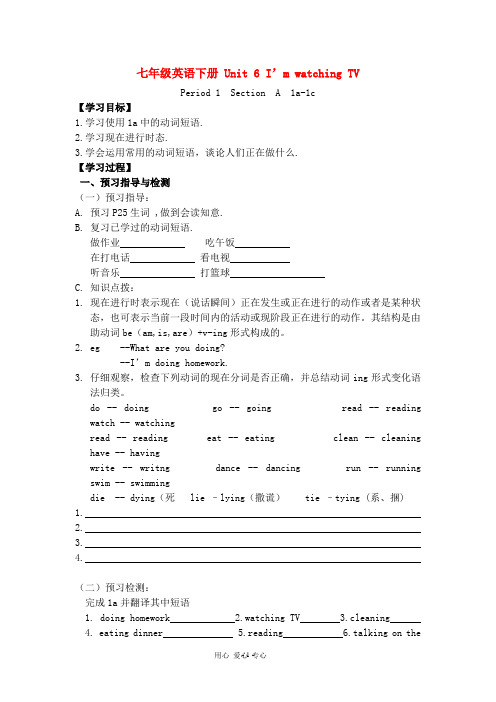
七年级英语下册 Unit 6 I’m watching TVPeriod 1 Section A 1a-1c【学习目标】1.学习使用1a中的动词短语.2.学习现在进行时态.3.学会运用常用的动词短语,谈论人们正在做什么.【学习过程】一、预习指导与检测(一)预习指导:A.预习P25生词 ,做到会读知意.B.复习已学过的动词短语.做作业吃午饭在打电话看电视听音乐打篮球C.知识点拨:1.现在进行时表示现在(说话瞬间)正在发生或正在进行的动作或者是某种状态,也可表示当前一段时间内的活动或现阶段正在进行的动作。
其结构是由助动词be(am,is,are)+v-ing形式构成的。
2.eg --What are you doing?--I’m doing homework.3.仔细观察,检查下列动词的现在分词是否正确,并总结动词ing形式变化语法归类。
do -- doing go -- going read -- readingwatch -- watchingread -- reading eat -- eating clean -- cleaninghave -- havingwrite -- writng dance -- dancing run -- runningswim -- swimmingdie -- dying(死 lie –lying(撒谎) tie –tying (系、捆)1.2.3.4.(二)预习检测:完成1a并翻译其中短语1. doing homework2.watching TV3.cleaning4. eating dinner5.reading6.talking on thephone二、课堂互动探究1.Pairwork: 使用句型What are you doing? I’m…谈论正在进行的动作。
2.得分小能手:看谁能用现在进行时态造句,并造的又多又准确,注意动词ing的结构哟。
人教版七年级英语下册Unit6I’mwatchingTV

一、教学目标
(一)知识与技能
1.能够正确听、说、读、写以下词汇:watch, read, write, play, do, homework, cook, listen, song, piano, at the moment, now, today, often, usually, often, sometimes, always等,并能在实际情境中灵活运用。
-学生在小组内进行讨论,记录下正在进行的动作。
-各小组代表向全班展示讨论成果,其他同学认真倾听并给予评价。
(四)课堂练习
1.教学活动设计:
-设计各种形式的练习题,如填空、选择、改错等,以巩固学生对现在进行时态和一般现在时的掌握。
-组织学生进行口语练习,如角色扮演、小组对话等,提高他们的口语表达能力。
-学生观看视频后,尝试用现在进行时态回答问题。
-教师邀请学生分享周末活动,引导学生用英语进行表达。
(二)讲授新知
1.教学活动设计:
-通过图片、闪卡等教具,呈现本单元的核心词汇和短语,如:watch TV, read a book, play soccer等。
-结合实例,讲解现在进行时态的构成和用法,引导学生关注动词ing形式的构成。
4.培养学生关注社会、关注环境,提高学生的社会责任感和环保意识。
5.通过学习英语,拓宽学生的国际视野,增强学生的跨文化意识。
本章节教学设计将围绕以上教学目标展开,通过丰富多样的教学活动,使学生在轻松愉快的氛围中学习英语,提高英语素养。
二、学情分析
针对人教版七年级英语下册Unit6 "I’m watching TV."的单元整体教学设计,在进行学情分析时,我们需要关注以下几个方面:
人教新目标版2013—2014年度下学期七年级英语教案Unit 6 I’m watching TV.

人教新目标版2013—2014年度下学期七年级英语教案主备人:备课时间:2014年月日成员:Unit 6 I’m watching TV.一、Teaching Goal:In this unit students learn to talk about what people are doing. Teach students how to cooperate and be good at watching something and love our lives.二、Teaching difficulties1. The vocabulary and the sentence structures.2. Learn the grammar: Present progressive tense.3. Oral practice using the target language.三、Teaching MethodsListening and practicing methods, pair work, Task-Based Learning method.四、Teaching AidsA tape recorder, some pictures and cards.五、Teaching Time: 5 periodsPeriod 1 (Section A:1a—2b)Teaching ProceduresStep 1.Revision1. Greetings.2. Revise the words and expressions in Unit 4.Step 2.Presatation: Lead in1. Do “Ask and answer” practice with the Ss.2. The teacher asks the students to give more verbs phrases and write them down on the blackboard.(show many pictures to help the Ss.)Teach the new words and expressions.3. Teach the Present Progressive.1)Introduction: Talk about the title of this unit. Show some pictures to introduce the Present Progressive tense.T: What’s she/he doing?Ss: She/He is v-ing (Help the Ss to answer the questions and show the sentences)2) Let the Ss to say what the Present Progressive is.3). Tell the differenceWrite down the V-ing forms by another lines of go, watch, do, play and eat . Ask the Ss to have a look and find the difference between them. For example: go and going, watch and watching, do and doing, etc. Then ask the Ss to read them again and do more exercises.Step3.Activity 1a:Match1. Help the Ss talk about the pictures. The Ss read these V-ing wordsafter the teacher. Match the words and the activities. Check the answers.2. Help the Ss do “Ask and answer” practice in pairs.3. Ask some Ss to do actions and let the class guess what he/she is doing.Step4.Activity 1b & 1c: Listening and pair work.1. Play the recording for the Ss to listen. Play again. Ss listen and write the number of the activity each person is doing. Check the answers.2. Pairwork: Ask the Ss to do “Ask and answer” practice about the picture in pairs. Some pairs present their dialogues to the class.Step 5.Activity 2a & 2b: Listening and Practice1.Activity 2a:Talk about the picture in 2b.Ask the Ss to read the questions in 2a. Then listen to the tape and and write the answers. Check the answers.2.Activity 2b:Play the recording again. Help the Ss put these questions and answers in order to make a conversation. Go through the answers with the Ss.Step 6 Pairwork: Activity 2c1.Talk about the pictures in 2c. Ask Ss to read the sample conversation. Let Ss look at the first group of pictures, and ask them to guess what the people are doing.2. Then imitate the sample conversation, work in pairs. Some pairs present their dialogues to the class.3. A guessing game: Guess the activities according to the Ss’ actions.Step 7 Homework: 1.Copy the new words and recite.2.Make up their own dialogues.教学后记:Period 2 (Section A:2d—3c)Teaching aimsGo on learning to talk about what people are doing.Language points1.To learn the following sentences.⑴—Is Nancy doing homework ?—Yes, she is ./No, she isn’t .She is writing a letter.⑵—Do you want to go to the movies? —Yes ,I do .⑶—When do you want to go? —Let’s go at six o’clock.2.To learn the following words and phrases:⑴adjective: sure⑵verb phrases: wait for , talk about , talk to sb.Teaching difficultiespresent participle: run-running , write-writing Present progressive tense: Subject +be+doing +…Teaching stepsWarming-up and revision⑴Watch VCD which is connected with the present progressive tense.⑵RevisionThe teacher asks Ss to do some actions, ask and answer one by one (chain work)T: What are you doing? S1: I am reading an English book. What are you doing ?S2: I am writing .What are you doing ? S3: I am playing the guitar. What are you doing?Show some pictures, point to them and ask.T: Look at picture 1! What is he /she doing ? S1: He/She is talking on the phone.T: Look at picture 2! What are they doing? S2: They are singing and dancing.T: Look at picture3. What is he doing? S3: He is swimming.2. PresentationThe teacher asks one student to come to the blackboard and do an action.T: Are you playing soccer? S: No, I’m not.T: Are you playing basketball? S : Yes, I am.Ask more students like this.PracticeHave students make a similar dialogue like thisS1: Are you reading a book? S2: No, I am not.S1: Are you reading a newspaper ? S2: Yes ,I am.4. Guessing gamesThe teacher uses pictures to ask the students. Cover one part of the picture and then uncover it little by little.T: What is he doing ? S1: Is he playing the computer?T: No, he isn’t . S2: Is he playing the guitar? (show another picture)What are they doing? Teacher continues to ask students and shows them more pictures.5. Pair work (work on 2c)T: let’s look at the pictures and guess what the people are doing. Please practise in pairs.A: Is Nancy writing a letter? B: No, she isn’t. She is writi ng a letter. Then check the answers.6. Work on 3aT: Look at the pictures and make conversations. Please write the correct number of the pictures next to the conversations below. Then check the answer. [Conversation A=3 Conversation B=2 ]The teacher reads the conversation before the class, and the Ss repeat the sentences. Ss practice the conversation in pairs and act out the conversation.7. Pair work(work on 3c)(1)Show a picture and teach the new phr ase“wait for a bus”.(2)Look at the pictures and answer the questions below. Ask Ss ask and answer like this.S1: Where is he? S2: He is in the store/ the supermarket.S1: What is he taking? S2: He is taking a bottle of juice.S1: What is he waiting for? S2: He is waiting for a bus.(3)T: Please look at the pictures again and talk about the four pictures.8. Grammar FocusWhat are you doing? What is he/she doing?I am watching TV. He is doing homework.Is he/she doing? Yes, he/she is./No, he/she isn’t/Are they doing? Yes, they are./ No, the y aren’t.9. HomeworkRead and recite 3a.Write the story about the four pictures.教学后记:Period 3 (Section B:1a-1e)Teaching aims询问别人正在哪里干某事. 继续学习某人正在干某事.Teaching pointsTo learn the following sentences.—Where do people play basketball? —At school.—Where is he swimming? —He is swimming at the pool.To learn the following vocabularies: toy, shopping, mall, pool.Teaching stepsWarming-up. chant and revisionChantWhat are you doing? I’m reading books.What is he doing? He is watching TV.What is she doing? She is doing homework.What are they doing? They are eating dinner.Revision Ask a student to do an action and askT: Are you eating breakfast? S1: No, I’m not .T: Are you singing? S2: Yes, I am .T: Is he writin g a letter? S3: No, he isn’t .T: What is she doing? S4: She is singing .T: Are you reading a newspaper? (To another student)S5: No, I’m not .T: What are you doing? S6: I am reading an English book .T: Is he reading a Chinese book? S7: No, he isn’t .T: Is she reading an English book? S8:Yes, she is .PresentationShow some pictures and present the new vocabularies .T: What is he doing?S1: He is swimming .T: Where is he swimming?S2: He is swimming in the river .T: No, he isn’t swimming in the river. He is swimming at the pool .T:Look! What are these? They are toys . What are the girl and her mother doing? They are shopping .T: Where are they shopping?S1: They are shopping in the store .S2: They are shopping in the supermarket .T: Maybe, look, they are shopping at the mall .PracticeShow some pictures and phrases, let Ss practice in pairs like this .A: What is he doing?B: He is boating .A: Where is he boating?B: He is boating on the river .Complete the chart . (work on 1a)T: Look at the pictures and complete the chart .Then check the answer .1). library reading books2). school playing basketball3). pool swimming4). mall shoppingPairworkLet Ss look at the chart , ask and answer in pairs .A: Where do people play basketball?B: At school .A: Where do people swim?B: At the pool .Listening comprehension2a. T: You will hear three short conversations. Please listen carefully and write down the places you hear in the chart below . Then check the answers: mall, school , library .2b. T: Now look at 1b on page 28. Please listen to the tape again and fill in the chart . Let’s write down what they are doing.Ss listen to the tape twice and write down the answer on their charts.7. Pairwork (work on 1c) .T: Now look at the chart and use the information in the chart to make a conversation like this .A: Hello! Is Tina there?B: No, she isn’t . She is at the mall .A: Oh, is he shopping at the mall ? / What is she doing ?B: No, she isn’t ./ She is eating lunch with a friend .8. Groupwork (Make a survey )1). T: Let’s make a survey, please ask Ss in your classroom where their parents are and what their parents doing now . Please ask and answer in threes, then fill in the chart .2.) After the Ss finish the survey .Let them give a report .9.Homework:1). Listen to the tape and repeat the conversation on Section B.2b.try to imitate the pronunciation and intonation.2). Collect some pictures and bring them to the classroom.3). Write the report down in the exercise book .教学后记:Period 4 (Section B:2a—2c)Teaching aims:Ss can use the present progressive tense to describe the pictures.Ss can ask and answer questions about the picture fluently.Language pointsTo use the following sentences:Here is a photo / picture of my family.I’m with my sister Gina.Thank you for your letter and the photosTo learn the following phrasesThank you for sth. / doing sth. be withTeaching difficultiesHow to write the sentences about the present progressive tense correctly.Teaching steps1.warming-up and revision(1)The teacher asks Ss some questions.T: Hello, how are you? S1: I’m great. Thank you.T: How is your father? S1: He is very well.T: Where is your father? S1: He is at the mall.T: What is he doing? S1: He is shopping.T: Is your father shopping now? S2: No, he isn’t. He is watching TV.T: Where is he watching TV? S2: He is watching TV at home.(2) Show some pictures, let Ss ask and answer the questions in pairs.S1: Look! What is she doing? S2: She is reading a book.S1: Where is she reading a book? S2: She is reading a book under a tree.2. Work on 3a.(1)Show the pictures of 3a and let Ss say it one by one.S1: He is playing basketball.S2: The girl is doing homework.S3: The boy is watching TV.S4: He is swimming.S5: They are eating and talking.(2) T: Here is a letter from Mike to his pen pal, Linda. Please read the letter and underline the activities and circle the places. Check the answers(3) T: Now read the letter again and number the photos, using 1,2,3,4.Check the answers: 1, 4, 2, 3(4) Let Ss work in pairs, ask and answer about the photos like this.A: What is Mike doing in Photo 1?B: He is playing basketball.A: Is he playing basketball at school?B: Yes, he is.3.WritingShow the pictures to the Ss and let Ss finish the sentences, then check the answers.They are dancing. He is running.Yao Ming is playing basketball.The teacher is writing. Xie Tingfeng is singing.4.Group workT: Now take out your photos or pictures, please work in fours and tell your partners about your pictures or photos. I’ll give you two minutes to practice it.T: At this time I’ll ask several students to say something about your photos.5. PracticeT: Take out the pictures or photos of your own and write one or two sentences about them.Ss write the sentences in their exercise books, the teacher walks around the class and see if the Ss can write the sentences correctly. Give Ss some help if necessary.The teacher collects some pictures and sentences, shows them to the Ss and checks the answers.6. Fill in the blanks. ( finish 2b)(1) T: Here is another photo, look at the photo and the letter next to it. Please take out your pens and fill in the blanks. Check the answers: watching TV reading the newspaper talking eating(2)Show the picture of 2b, let Ss say the picture like this:7. Homework.Write a short composition about your own photos or pictures.教学反思:Period 5 (3a-Selfcheck)Teaching aims:Revise the contents of Unit 6.Ss can use the present progressive tense correctly.Language pointsRevise the key words, phrases and sentences in this unit.To learn two new words: camera, birdKey points and teaching difficulties.Consolidate the present progressive tense.Teaching steps:Step 1 Warming-up and revisionLet one student take out a photo or a picture of his / her own and show it to the whole class, then he / she will ask some questions about the photo or the picture.S1: Where is my father?S2: He is…..S1: What is he doing?S3: He is…S1: Is my mother doing…?S4: No, she isn’t. She is …Ask more Ss to come to the blackboard to do it.Step 2 PresentationUse two pictures and present the new words: camera, birdT: What is this?S1: Sorry, I don’t know.T: It’s a camera. We can use a camera to take a photo.T: Look! What is it? S2: It’s a bird.T: That’s right. What is the bird doing?S3: I think it is singing.S4: I think it is flying.Step 3 Complete the storyT: Look at the pictures on Page 30, Part 3. please complete the story and write the sentences in the blanks.Check the answers:What is he doing? He is looking at the birds.What are they doing? They are talking.What is the boy doing? He is running.What is the boy carry? He is carrying a bag.What is in the bag? It’s a camera.What is the boy doing? He is taking a photo.Step 4 Divide the Ss into two parts and read the dialogue. Let Ss act out the dialogue.Step 5 Key words checkStep 6 HomeworkReview the key words and phrases.教学后记:。
唐河县第八中学七年级英语下册Unit6I’mwatchingTV第1课时学案无答案新版人教新目标版
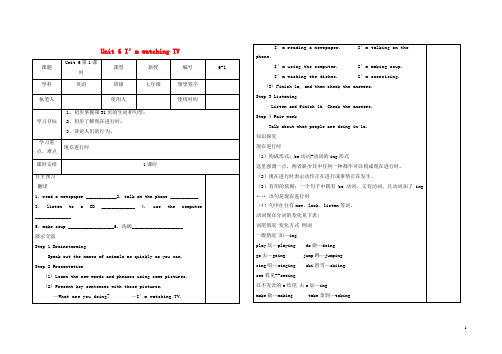
Unit 6 I’m watching TVUnit 1 My name’s Gina.Period 4 Section B 2a-2c【课型】读说课学习目标1.学生能掌握本课重点词汇:first name,last name,friend,China;能正确书写中英文姓名,并正确区分中英文姓名中的姓氏和名字;能认识到中、英文姓氏和名字顺序的差异。
2.学生能运用What’s your first name?What’s your last name?及其答语对对方姓氏、名字进行简单的问答练习。
3.学生能读懂含有本课重点词汇和介绍姓名、电话号码等目标语言的语言材料。
初步了解读前预测、粗读、细读和搜索关键词找到有效信息的阅读技巧。
学习过程【自主学习】一、通过前三节课的学习,你记住了哪些英文名字,请试着写下它们吧!男名:女名:二、根据提示补全下列短文中的内容,介绍小组成员的信息。
Hello,everyone.There are kids in my group.He is (中文姓名).His English name is .His telephone number is .is a girl.Her English name is .Her telephone number is .I am .My English name is .My telephone number is .We are good friends.【师生互动】[新课导入]Group work根据提示,完成下列问答,进一步完善自主学习二的信息。
A:Hello!What’s your English name?B:My English name is...A:What’s your telephone number?B:My telephone number is...A:Nice to meet you.B:Nice to meet you,too.[新知呈现]试读下列姓名,仿照例子,尝试总结归纳Zhang Lanlan,Song Zuying,Liu Dabao.Yao MingFirst name:Ming Last name:Yao[新知学习]▲课堂探究提出问题“What’s your Chinese name?”Write down the names.以拼音字母的形式写出你的中文名字,注意写法特点。
2023年人教版七年级英语下册Unit 6 I’m watching TV学案

Unit 6 I’m watching TV学案一、words:(n) newspaper, soup, movie, house, tea, tomorro w, pool, shop, supermarket, man(men), race, host, state, the United States, American, dragon, Dragon Boat Festival, child(children) ,living room(v) use, wash, drink, study, miss, wish(adj) young ,delicious其他:just, any, other, still1 newspaper/ a newspaper/ read a newspaperWhat is she doing? She is reading a newspaper.I often read newspapers after dinner.2 soup/ make soup/ The soup tastes delicious.3 movie/ see a movie/ go to see a movie/ go to see the movies/ go to the cinema/ go to see a film4 house/ housework/ go to my friend’s house/ a white house/I often clean my house on weekend. Look! My mother is cleaning our house now.5 tea/ make tea/ drink tea/ a cup of tea/What are you doing? I am drinking a cup of tea.6 tomorrow/ today/ yesterday/ the day after tomorrow/ the day before ye sterday/Can you come to my house tomorrow?Are you free tomorrow?Let’s go to the movies.7 pool/ swimming pool/There is a beautiful house with a big swimming pool.8 supermarket/ g o to the supermarket/There is a big supermarket near our school.9 man (men)/ man teacher/ men teachersThere is a man swimming in the river.Is there a man swimming in the river?10 race/ the boat raceHis dad and uncle are watching the boat races on TV.11 host/ my host family/ his host family12 state/ the United States/the United States of American13 dragon / Dragon Boat FestivalToday is Dragon Boat Festival14 child (children)/ kidThe mother is reading a story to her young children.The children are playing basketball on the play ground.15 living room/ clean the living roomMy parents are cleaning the living room.16 shop: go to the shop/ go shoppingShe is buying some milk in the shop.Let’s go shopping!17 use/ use the computer/ use the CD playerShe is using the computer.18 wash/ wash the clothes/ wash the dishes/ do the dishes.Is she washing her clothes at home? No, she isn’t. She is washing the dishes in the kitchen.19 drink/ drink a cup of tea/ drink some water/ drink tea/Mary’s parents drink tea after dinner.20 study/ study EnglishShe is studying in the United States.21 miss/miss my hometown/ miss my motherShe really miss her best friend.22 wish/best wishes/ I wish to have my mom’s delicious food.23 young- old/ the young/ the old/24 delicious/ delicious food/二、phrases (短语)1 read a newspaper---reading a newspaper2 talk on the phone--- talking on the phone3 go to the movies---going to the movi es4 make soup---making soup5 make dinner----making dinner6 wash the dishes—washing the dishes7 wash my clothes---washing my clothes8 drink tea---drinking tea9 clean the living room---cleaning the living room10 talk on the phone—talking on the phone11 listen to a CD--- listening to a CD12 use the computer---using the computer13 exercise---exercising14 do my homework---doing my homework15 clean the house----cleaning the house16 join me /join me for dinner/ Do you want to join me for dinner?17 eat outMy parents aren’t at home. We can eat out.18 at half past six19 see you/ see you tomorrow./see you then/ see you tomorrow evening.20 what about you/ how about you21 It is kind of boring/ It is not very interesting22 That sounds good./ That sounds boring.23 play basketball at school24 buy milk and bread in the supermarket25 swim in the swimming pool/ swim in a river26 read a newspaper in the library27 study in the United States28 live with an American in New York29 Dragon Boat Festival30 watch the boat race on TV/ watch a soccer game on TV/ watch … on TV31 read a story to her young children32 wish to have his mom’s delicious food/wish to do sth33 like his host family a lot/= like his host family very much/ like… a lot34 the night before the festival35 his host family36 talk on the phone to his cousin37 miss his family38 no place like home39 a picture of my family40 in the living room41 listen to the radio42 talk show / This talk show is interesting.TV show /My TV show in also not very interesting.43 study for a test/ He is studying for a test.44 play soccer with me/三、句型1 (1) I’m watching TV.---- I’m not watching TV. Are you watching TV?--- Yes, I am./ No, I’m not. What are you doing ?(2) She is talking on the phone.She isn’t talking on the phoneIs she talking on the phone?Yes, she is./ No, she isn’t .What is she doing?(3) He is reading a newspaper.He isn’t reading a newspaper.Yes, he is./ No, he isn’t.What is he doing?(4)They are washing the dishes.They aren’t washing the dishes.Are they washing the dishes?Yes, they are. No, they aren’t.What are they doing?2 Do you want to go to the movies?Do you want to join me for dinner?Do you want to play basketball with me?Do you want to go to the zoo with your frien ds?3 What are you doing?—not much.4 Let’s meet at my home first.Let’s go to see the pandas first.Let’s play the guitar fi rst.5 Hello? This is Jenny./ It is Jenny speaking.---Hi, Jenny. It is Laura here./ This is Laura.Is that Jack speaking?/ Is it Jack speaking?6 Would you like to go to the movies with me? Yes, I’d love to.7 I am just washing my clothes.8 My parents aren’t at home. We can eat out.9 What time is it in Beijing?—it is eight o’clock in the morning.What is the time now?= What time is it now?10 Today’s story is about Zhu Hui.11 He is now studying in the Unit ed States.He is living with an American family in New York.His mom and aunt are making zongzi. His dad and uncle are watching the boat race on TV.The mother is reading a story to her young children.The father is watching a soccer game on TV. He is talking on the phone to his cousin in Shenzhen.12 In New York, it is the night before the festival. But there isn’t a Dragon Boat Festival in the US, so it is like any other night for Zhu Hui and his host family.13 Zhu Hui misses his family and wishes to have his mom’s delicious zongzi.14 Here is a picture of my family. We are all at home now.。
人教版英语七年级下册Unit 6 I’m watching TV学案(无答案)

U nit 6 I’m watching TV .The First Period Section A (1a---1c)学习目标知识目标:1.学习现在进行时态,学会谈论人们正在做什么;2.学习使用1a中的动词短语。
能力目标:通过描述日常生活中人们正在做的事,培养学生能就发生的事情做现场报道。
学习重点学会谈论人们正在做什么。
学习难点现在分词的构成和现在进行时态的结构学习过程一、知识链接(温故知新)话题链接在以前的学习中,我们谈论的都是经常性的或习惯性的动作,用的是一般现在时态。
如:We watch TV in the evening .He plays computer on Sunday.(谓语动词用原形,当主语为第三人称单数时,谓语动词用三单式)。
今天我们要谈论说话时正在进行的动作或进行的状态,就要用到现在进行时。
如:We are watching TV now . Look ! He is playing computer .在英语中,随着时间的改变,句子中的谓语动词也要有变化。
二、课前自学预习指导:1. 请阅读教材112页的语法,了解现在进行时的结构:助动词be(am,is,are)+v-ing形式构成的。
2. 小组拼读单词并相互听写比赛newspaper 报纸, read a newspaper 看报纸,use 使用;运用,soup 汤,make soup 做汤,wash 洗3. 探索发现动词现在分词的变换规则。
①观察play—playing; read—reading; go—going发现,一般动词变现在分词是在动词后面+____________.②观察take—taking; come—coming; dance—dancing发现,以e结尾的动词变现在分词要___________________________.③观察run—running; begin—beginning; get—getting发现以重读闭音节结尾的单词,且词尾只有一个辅音字母变现在分词应_________________________________.④观察study—studying; fly—flying发现,以字母+ 结尾的动词变现在分词是_____________________________________.尝试练习:读下列动词,翻译并试着写出动词的-ing形式do()_________read()_________watch()_________ talk()_________ clean()_________wash()________listen()________use()_________ make()_________ run()_________exercise()_________go()_________ 2. 预习1a并翻译其中短语看电视______ ___在电话中交谈____ _____ 看报____ _____ 听CD___ ______使用电脑做汤洗餐具温馨提示:英语中“看”法各异。
七年级英语下册 Unit 6 I’m watching TV学案 (新版)人教新目标版-(新版)人教
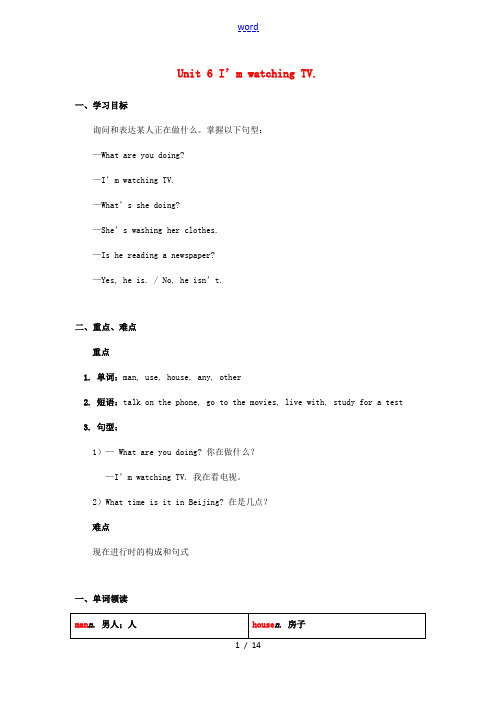
Unit 6 I’m watching TV.一、学习目标询问和表达某人正在做什么。
掌握以下句型:—What are you doing?—I’m watching TV.—What’s she doing?—She’s washing her clothes.—Is he reading a newspaper?—Yes, he is. / No, he isn’t.二、重点、难点重点1. 单词:man, use, house, any, other2. 短语:talk on the phone, go to the movies, live with, study for a test3. 句型:1)— What are you doing? 你在做什么?—I’m watching TV. 我在看电视。
2)What time is it in Beijing? 在是几点?难点现在进行时的构成和句式一、单词领读use v.使用;运用other adj. 另外的;其他的pron.另外的人(或物)any adj.任何的;任一的pron.任何;任一二、重点单词【单词学习】☆☆1. use v.使用;运用【用法】及物动词。
【例句】—Can I use your bike? 我可以用一下你的自行车吗?—Sure. 当然可以了。
【拓展】(1)use n.用法;使用;用途(2)useful adj.有用的;有益的(3)useless adj.无用的【例句】He makes good use of his time. 他充分利用他的时间。
English is useful to you. 英语对你来说有用。
Why do you think it’s useless? 你为什么认为它没用呢?【考题】Can you help me ______ the puter? I think it’s very _______.A. use; usefulB. to use; uselessC. useful; useD. use; useless答案:A思路分析:help sb. (to) do sth.,故C项错误;根据前句“你能帮助我使用电脑吗?”可知“我认为它是很有用的”,故用useful。
七年级英语下册 Unit 6 I'm watching TV学案2(无答案)(新版)人教新目标版
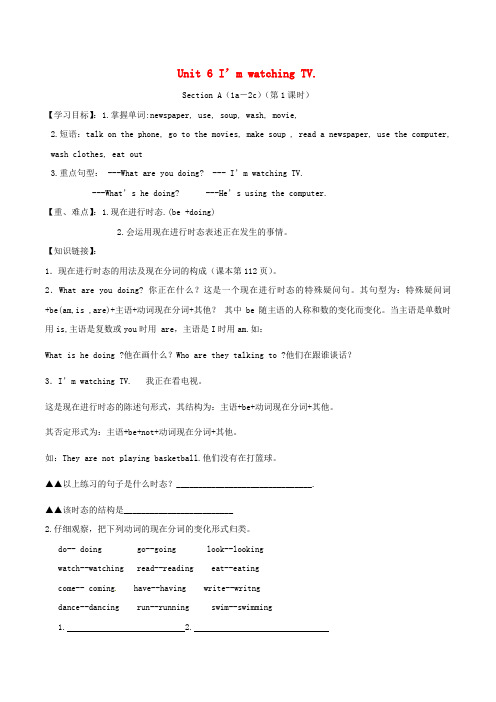
Unit 6 I’m watching TV.Section A(1a-2c)(第1课时)【学习目标】:1.掌握单词:newspaper, use, soup, wash, movie,2.短语:talk on the phone, go to the movies, make soup , read a newspaper, use the computer, wash clothes, eat out3.重点句型: ---What are you doing? --- I’m watchin g TV.---What’s he doing? ---He’s using the computer.【重、难点】:1.现在进行时态.(be +doing)2.会运用现在进行时态表述正在发生的事情。
【知识链接】:1.现在进行时态的用法及现在分词的构成(课本第112页)。
2.What are you doing? 你正在什么?这是一个现在进行时态的特殊疑问句。
其句型为:特殊疑问词+be(am,is ,are)+主语+动词现在分词+其他?其中be随主语的人称和数的变化而变化。
当主语是单数时用is,主语是复数或you时用 are,主语是I时用am.如:What is he doing ?他在画什么?Who are they talking to ?他们在跟谁谈话?3.I’m watching TV. 我正在看电视。
这是现在进行时态的陈述句形式,其结构为:主语+be+动词现在分词+其他。
其否定形式为:主语+be+not+动词现在分词+其他。
如:They are not playing basketball.他们没有在打篮球。
▲▲以上练习的句子是什么时态?_______________________________.▲▲该时态的结构是_________________________2.仔细观察,把下列动词的现在分词的变化形式归类。
七年级下册Unit6《I’mwatchingTV》教学设计
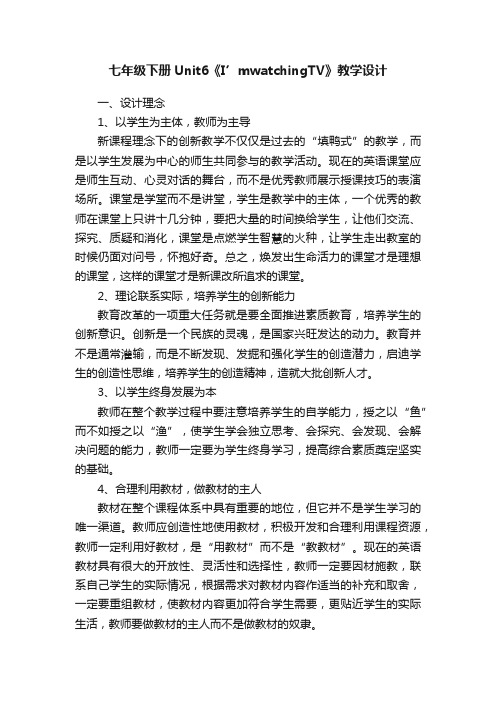
七年级下册Unit6《I’mwatchingTV》教学设计一、设计理念1、以学生为主体,教师为主导新课程理念下的创新教学不仅仅是过去的“填鸭式”的教学,而是以学生发展为中心的师生共同参与的教学活动。
现在的英语课堂应是师生互动、心灵对话的舞台,而不是优秀教师展示授课技巧的表演场所。
课堂是学堂而不是讲堂,学生是教学中的主体,一个优秀的教师在课堂上只讲十几分钟,要把大量的时间换给学生,让他们交流、探究、质疑和消化,课堂是点燃学生智慧的火种,让学生走出教室的时候仍面对问号,怀抱好奇。
总之,焕发出生命活力的课堂才是理想的课堂,这样的课堂才是新课改所追求的课堂。
2、理论联系实际,培养学生的创新能力教育改革的一项重大任务就是要全面推进素质教育,培养学生的创新意识。
创新是一个民族的灵魂,是国家兴旺发达的动力。
教育并不是通常灌输,而是不断发现、发掘和强化学生的创造潜力,启迪学生的创造性思维,培养学生的创造精神,造就大批创新人才。
3、以学生终身发展为本教师在整个教学过程中要注意培养学生的自学能力,授之以“鱼”而不如授之以“渔”,使学生学会独立思考、会探究、会发现、会解决问题的能力,教师一定要为学生终身学习,提高综合素质奠定坚实的基础。
4、合理利用教材,做教材的主人教材在整个课程体系中具有重要的地位,但它并不是学生学习的唯一渠道。
教师应创造性地使用教材,积极开发和合理利用课程资源,教师一定利用好教材,是“用教材”而不是“教教材”。
现在的英语教材具有很大的开放性、灵活性和选择性,教师一定要因材施教,联系自己学生的实际情况,根据需求对教材内容作适当的补充和取舍,一定要重组教材,使教材内容更加符合学生需要,更贴近学生的实际生活,教师要做教材的主人而不是做教材的奴隶。
5、注重面向全体学生,构建和谐课堂由于学生之间的个性差异,每个班级都有两极分化现象。
针对这种情况,教师的眼睛不能只盯着几个优生,要面向全体学生。
教学的内容要满足各个层次的学生,特别要关注学困生。
七年级英语下册《Unit6IamwatchingTV》教案(新版)人教新目标版

Unit 6 I am watching Tv知识目标:一、Learn the new words and ph rases:1.Newspaper2.read a newspapere4.soup5.make soup6.wash7.movie8.go tomovie s9.just 10.eat out二、掌握下列句型:What are you doing? I’m watching TV.What is he doing ? He is washing his cl othes.What is she doing ? She is washing her clothes.What are they doing? They are listening to a CD.Is he washing hi s clothes? No, he isn’t. He is playing basketball.能力目标: 1.能够掌握现在进行时态的用法。
2. 能够掌握w hat 引导的特殊疑问句。
情感目标:谈论自己和他人正在做的事情。
教学过程:●Step 1: Show some pictures(PPT) to learn some new words:1.newspaper2.read a newspapere4.soup5.make soup6.wash7.movie8.go to movies9.just 10.eat out●Step2: learn 1a: Match t he activities with the people.First read the words, then match.Check the answers. 1--.i 2—d3—g4—a(i), 5—h ,6—e ,7—b; 8.---c 9--f●Step3.Presentation Learn the following sentences by PPT:1. What are y ou doing? I’m watching T V.2.What is he doin g ? He is washing his clothes.3.What is she doing ? She is washing her clothes.4. What are they doing? The y are listening to a CD.5.Is he washing his clothes? No, h e isn’t. He is playing basketball.●Step4: Listen to 1b and number the conversations.First let the Ss listen carefully.. Then check the answers. a—1; b---8; c----5 ●Ste p5: Pairwork:According to 1b—Practice the conversations like t his:A: What is he doing ?B: He’s using the computer.A: What are they doing?B: They are listening to a CD.●Step6: Listening 2aListen to 2a and match the answers.Check the●Step7:Lis tening:Listen again. Complete the sentences.are doing; watching TV ; listening toa CD ; boring; interesting; go to●Step8: Role- play the conversation in 2b●Step 9: Summary1. What are you doing? I’m watching TV.2.What is he doing ? He is washing his clothes.3.What is she doing ? She is washing her clothes.4. What are the y doing? They are listening to a CD.5.Is he wa shing his clothes? No, he isn’t. He is playing basketball.●Step10. Test1. Who _____ over there now?A. singingB. are singC. is singingD. sing2. It’s eight o’clock. The students _____ an English class.A. haveB. havingC. is havingD. are having3. Listen! The baby _____ in the next room.A. cryingB. criedC. is cryingD. cries4. Look! The twins _____ new sweaters.A. are wearingB. wearingC. are wearD. is wearing5. Don’t talk here. Grandparents _____.A. is sleepingB. are sleepingC. sleepingD. sleep教学后记:学生学习积极性较高,对于所学知识掌握较好。
初中英语《Unit6 Iam watching TV》主题单元教学设计以及思维导图

Unit6Iam watching TV5.学生能独立完成Unit6的单元综合测试。
主题单元规划思维导图主题单元学习目标本专题的主要学习设计活动如下:1、创设问题情景,导入对话交流。
师生对话,导入问题如下:“What are you doing? What’she/he doing? Is he/she…?”提问第1个问题以前,利用多媒体呈现几张动作图片:2、开展阅读活动,实现生本对话。
A.阅读语篇,回答问题。
引导学生运用Skimming阅读方法,快速获取答案。
B. 再读语篇,选择段落大意。
引导学生运用Scanning阅读方法,快速获取有效信息。
新文段的补充,使学生认识到英语学习材料的丰富性,感受英语学习的乐趣。
在阅读过程中,学生的预测、略读、跳读及布局谋篇、遣词造句等技能再次的得到训练和提高。
C.再读文段,画出主要话题功能句。
在语篇情景中,完成对主要功能句的复习和梳理。
学生充分体验归纳、概括等识记策略。
D.提出问题,构建篇章结构。
针对老师提出的问题,学生首先独立思考,之后开展研究性学习,进行小组合作探究。
共分7个小组。
组内异质,组间同质。
3、依据篇章结构图,进行文段复述。
A. 自主朗读,熟悉语篇。
B.小组内复述。
C.小组代表向全班同学复述。
学生在完成任务的过程中,再次感悟体验写作时的布局谋篇;在赏析语言的过程中,感悟遣词造句的方法。
4、借助文段仿写,运用所学,写出开放性写作。
(详见研究性学习设计)A. 自主学习:学生独立思考,完成书面表达任务的结构框架,写出所用词汇和主要功能句。
B.探究合作:基于独立完成的组内交流、修订,体现生生互助。
C.自主学习:依据讨论后修订的框架和所写词、句,自主完成书面表达。
D.再次合作探究:组内交流、修订,完善作品。
推荐出小组最佳征文。
E. 班级交流:各小组选出1名代表,到讲台朗读小组最佳征文。
老师及其他学生对最佳征文根据评价量规对其进行评价。
通过完成该任务,学生的综合语言运用能力,特别是写的能力得到提升,同时通过交流达成读写课中以读带写的目标。
(人教版)七年级下册英语导学案:Unit 6 I’m watching TV
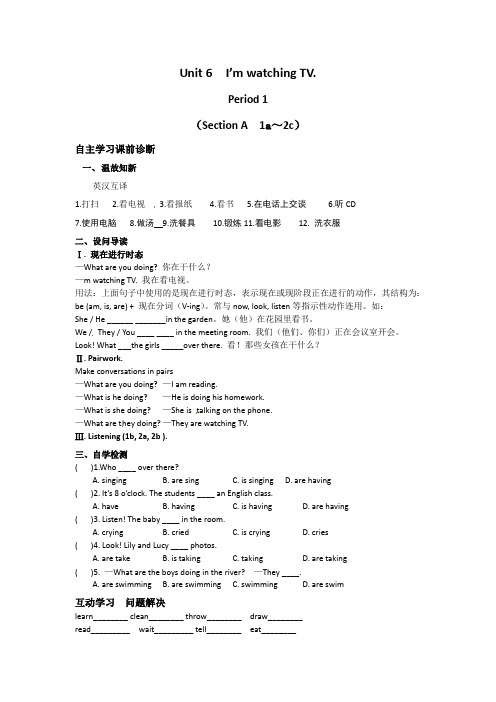
Unit 6 I’m watching TV.Period 1(Section A 1a~2c)自主学习课前诊断一、温故知新英汉互译1.打扫2.看电视3.看报纸4.看书5.在电话上交谈6.听CD7.使用电脑8.做汤9.洗餐具10.锻炼11.看电影12. 洗衣服二、设问导读Ⅰ. 现在进行时态—What are you doing? 你在干什么?—m watching TV. 我在看电视。
用法:上面句子中使用的是现在进行时态,表示现在或现阶段正在进行的动作,其结构为:be (am, is, are) + 现在分词(V-ing)。
常与now, look, listen等指示性动作连用。
如:She / He ______ _______in the garden。
她(他)在花园里看书。
We /They / You ____ ____ in the meeting room. 我们(他们、你们)正在会议室开会。
Look! What ___the girls _____over there. 看!那些女孩在干什么?Ⅱ. Pairwork.Make conversations in pairs—What are you doing? —I am reading.—What is he doing? —He is doing his homework.—What is she doing? —She is talking on the phone.—What are they doing? —They are watching TV.Ⅲ. Listening (1b, 2a, 2b ).三、自学检测( )1.Who ____ over there?A. singingB. are singC. is singingD. are having( )2. It’s 8 o’clock. The students ____ an English class.A. haveB. havingC. is havingD. are having( )3. Listen! The baby ____ in the room.A. cryingB. criedC. is cryingD. cries( )4. Look! Lily and Lucy ____ photos.A. are takeB. is takingC. takingD. are taking( )5. —What are the boys doing in the river? —They ____.A. are swimmingB. are swimmingC. swimmingD. are swim互动学习问题解决learn________ clean________ throw________ draw________read_________ wait_________ tell________ eat________carry________ worry________ say________ play________listen________ visit________ water________ open________come_____ __ make________ take________ hike________write________ give________ ride_______ have________swim________ get________ begin________ shop________sit________ run________ put_________ stop________学用结合能力提升连词成句1. your, pals, pen, doing, are, what___________________________?2. father, reading, newspaper, the, his, is________________________.3. some, of, are, here, my, photos_________________________.4. dinner, she, eating, is, now_________________________.5. at, pool, swimming, am, the, I__________________________.课堂小节,形成网络Talk about what your family are doing at 8:00 p.m._________________________________________________________________________ _________________________________________________________________________ __________________________________________________________________________Unit6 I’m watching TV .Period 2(Section A 2e~3c)自主学习课前诊断温故知新I.翻译下列短语1. 打扫_________2.公寓_______3.在电话上交谈__________4.看电视_____5.做作业_____6.吃饭_ __7.看书_________II. Ⅱ. Pairwork.Dialogue 1—What are you doing? —I am V-ing.Dialogue 2—What is he / she doin g? —He / She is V-ing.二、设问导读Ⅰ. Read P32 (2e) and answer the following questions.1. What’s Laura doing?2. What’s Jenny doing?3. What do they want to do?4. What time do they meet?Ⅱ. Read P33 (Grammar focus). Then finish P33(3a, 3b, 3c) with your partner.自学检测Ⅰ. Pairwork.Practice P32 (2e) with your partner and make your own conversation. Then act it out.Ⅱ. 单项选择( )1. Do you want ___ to the movies with us this evening? Your best friend Julie will go,too.A. goB. to goC. goes D . going( )2. Look! Jim and Li Lei are ___TV. Do you want to join them?A. watchB. seeingC. looking atD. watching( )3. Jack and Tom often do ____ at school.A. his homeworkB. their homeworksC. their homeworkD. they homework( )4. After one day's work, my father often ____ newspapers.A. looksB. seesC. watchesD. reads( )5. —____ cleaning the classroom? —Mike.A. Who doesB. Who'sC. WhoD. Who are互动学习问题解决现在进行时态一、用法:1. 表示现在(说话瞬间)正在进行或发生的动作。
人教新课标七年级英语下册教学设计 《Unit 6 I'm watching TV》(4课时)
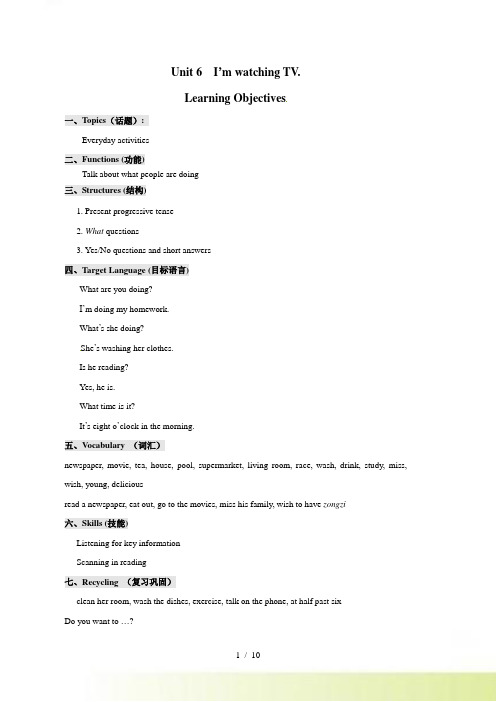
Unit 6 I’m watching TV.Learning Objectives一、Topics(话题):Everyday activities二、Functions (功能)Talk about what people are doing三、Structures (结构)1. Present progressive tense2. What questions3. Yes/No questions and short answers四、Target Language (目标语言)What are you doing?I’m doing my homework.What’s she doing?She’s washing her clothes.Is he reading?Yes, he is.What time is it?It’s eight o’clock in the morning.五、Vocabulary (词汇)newspaper, movie, tea, house, pool, supermarket, living room, race, wash, drink, study, miss, wish, young, deliciousread a newspaper, eat out, go to the movies, miss his family, wish to have zongzi六、Skills (技能)Listening for key informationScanning in reading七、Recycling (复习巩固)clean her room, wash the dishes, exercise, talk on the phone, at half past sixDo you want to …?It’s kind of …Let’s meet at …八、教材分析本单元主要围绕“What are you doing?”这一主题展开各种教学活动,并以这一主题引出现在进行时的一般疑问句,否定句以及特殊疑问句等语言功能。
Unit6I’mwatchingTVSectionB3a-selfcheck教学设计人教版七年级英语
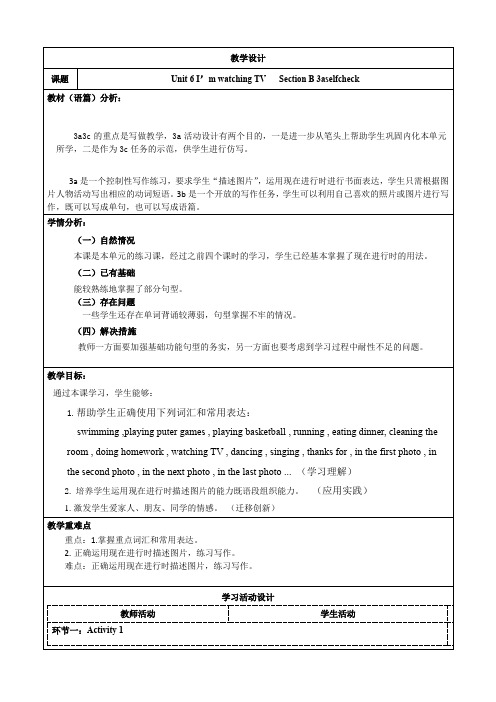
(一)自然情况
本课是本单元的练习课,经过之前四个课时的学习,学生已经基本掌握了现在进行时的用法。
(二)已有基础
能较熟练地掌握了部分句型。
(三)存在问题
一些学生还存在单词背诵较薄弱,句型掌握不牢的情况。
(四)解决措施
教师一方面要加强基础功能句型的务实,另一方面也要考虑到学习过程中耐性不足的问题。
环节五:Activity5
教的活动5 Work on Self Check
1.Add more words in the chart . Then write at least five sentences using the words.
2.Write questions to plete the conversation.
分层作业设计
1.基础巩固:
熟记本单元的单词、词组和重点单词。
设计意图:熟记本课重点单词和短语。
2.能力提升:
注意观察同学们在课件活动,用现在进行时写一篇报道。
设计意图:在语境中填写单词,提高学生对目标语言的运用能力。
教学反思与改进
本节课以实现素质教育为目的,运用《新课程标准》相关章节理论,结合教材重点、难点及英语学科特点,利用多媒体辅助教学,从视、说、写等方面使学生得到锻炼,让学生在愉快、轻松的氛围中学习新知,达到了初步运用英语进行交际和书面表达的水平,让学生在具体语境中感悟、理解和学习现在进行时。
学的活动5
Ask and answer .
活动意图说明:
此环节是检测学生是否能正确运用动词ing形式,并让学生更多的动词写出相应的动词ing形式。运用现在进行时将一个对话补充完整,能够培养学生根据上下文语境推测语句的逻辑推理能力。
新人教版七年级英语下Unit 6 I'm watching TV 教学案

Unit 6 I'm watching TV. (第一课时Section A 1a—1c)【学习目标】1.学习使用1a中的动词短语;2.学习现在进行时态;3.学会运用常用的动词短语,谈论人们正在做什么。
【重、难点】1.交际中现在进行时的正确运用; 2.动词短语的运用。
一.回顾已知,导入新课1.看电视_______________2.清洗餐具__________________3.听音乐_________________4.他们来自哪里?__________________________5.你为什么喜欢猴子?_________________二.自主学习,边学边导学习任务一:1.学习并熟练掌握本节课的新词汇,写出下列中文意思。
newspaper read a newspaper use soup make soup wash2.认真观察1a中的图片,将活动与图片搭配,小组讨论并核对答案。
3.听录音,完成1b,小组讨论核对答案.学习任务二:询问他人正在做什么,引出现在进行时态,总结现在进行时态的构成be动词(am/is/are)+ doing学习任务三:看图片1a,熟练练习、掌握询问他人正在做什么的句型:What’s he/she doing?和What’re you/they doing?三.精讲点拨,精练提升现在进行时表示正在进行的动作或存在的状态。
一般有be动词(am, is, are)加上动词的现在分词(即动词的ing形式)构成。
通常句子中常有now, Look! Listen! It’s two o’clock now.等表示正在进行的时间状语。
1.My brother is watching TV. (对划线部分提问)________ your brother ________?2. Tom and I ___ music now.A. are listeningB. are listening toC. listening3. Are they having lunch at home now? (用every day 替换now)_______they ________lunch at home every day?4. They’re playing basketball. (划线提问)_______are they _________?四.达标检测,当堂过关(一)单选选择( )1. Look,! They _______ games over there.A. is playB. is playingC. are playing( )2. We are doing ___________________.A. our homeworkB. my homeworkC. one’s homework( )3. Jim and his teacher ____________ over there.A. is talkB.is talkingC. are talking( )4. Lily __________ the blackboard.A. is lookingB. is looking atC. looking( )5. They are _________ books. A. seeing B. reading C. watching ( )6. _________ are the students doing in the classroom now?A. WhatB. WhereC. When( )7.---- Is the boy using the computer? ---_________A. Yes, he doesB. No, he isn’tC. No, he doesn’t( )8.----What ____ your family doing? ----They’re watching TV.A. isB. doesC. are( )9.Your idea __________ good.A. listensB. soundC. sounds( ) 10. It’s twelve o’clock now. The Greens _______lunch at home.A. haveB. is havingC. are having(二)读短文,回答问题。
人教版七年级下册英语Unit6I'mwatchingTVReading优秀教学案例

1.教师将学生分成小组,每组选择一个家庭成员,讨论该家庭成员的日常生活活动,并准备进行角色扮演。
2.教师提出讨论问题,如“What does your partner prefer to do in their free time?”,引导学生进行交流和思考。
3.教师鼓励学生用英语进行讨论,培养他们的语言运用能力和合作学习能力。
人教版七年级下册英语Unit6I'mwatchingTVReading优秀教学案例
一、案例背景
本案例背景以人教版七年级下册英语Unit6 "I'm watching TV" Reading部分为基础,旨在通过一堂生动有趣的英语课,帮助学生掌握日常生活中的常用表达方式,提高学生的英语阅读理解能力,并培养他们的跨文化交际意识。
本节课的教学目标是使学生能够正确运用所学知识进行日常交流,提高他们的英语阅读理解能力,并培养他们积极向上的生活态度。通过本节课的学习,学生能够更好地了解英语文化,提高他们的跨文化交际能力。
二、教学目标
(一)知识与技能
1.学生能够掌握日常生活中关于家庭成员活动的常用表达方式,如“I'm watching TV”,“My mother is cooking dinner”等。
3.教师组织学生进行同伴评价,鼓励学生相互鼓励、相互学习,共同进步。
4.教师对学生的学习成果进行评价,关注学生的全面发展,给予肯定和鼓励,激发学生的学习积极性。
作为一名特级教师,我深知教学策略在教学过程中的重要性。在教学过程中,我将注重情景创设,激发学生的学习兴趣;通过问题导向,培养学生的思考能力;运用小组合作,提高学生的合作能力;引导学生进行反思与评价,提升学生的自我管理能力。同时,我将关注每个学生的个体差异,给予他们个性化的指导和支持,帮助他们实现全面发展。总之,我将竭尽所能,为学生的成长和进步贡献自己的力量。
- 1、下载文档前请自行甄别文档内容的完整性,平台不提供额外的编辑、内容补充、找答案等附加服务。
- 2、"仅部分预览"的文档,不可在线预览部分如存在完整性等问题,可反馈申请退款(可完整预览的文档不适用该条件!)。
- 3、如文档侵犯您的权益,请联系客服反馈,我们会尽快为您处理(人工客服工作时间:9:00-18:30)。
Unit 6 I’m watching TV.一、学习目标询问和表达某人正在做什么。
掌握以下句型:— What are you doing?—I’m watching TV.—What’s she doing?—She’s washing her clothes.— Is he reading a newspaper?—Yes, he is. / No, he isn’t.二、重点、难点重点1. 单词:man, use, house, any, other2. 短语:talk on the phone, go to the movies, live with, study for a test3. 句型:1)— What are you doing? 你在做什么?—I’m watching TV. 我在看电视。
2)What time is it in Beijing? 在北京是几点?难点现在进行时的构成和句式一、单词领读二、重点单词【单词学习】☆☆1. use v.使用;运用【用法】及物动词。
【例句】— Can I use your bike? 我可以用一下你的自行车吗?— Sure. 当然可以了。
【拓展】(1)use n.用法;使用;用途(2)useful adj.有用的;有益的(3)useless adj.无用的【例句】He makes good use of his time. 他充分利用他的时间。
English is useful to you. 英语对你来说有用。
Why do you think it’s useless? 你为什么认为它没用呢?【考题链接】Can you help me ______ the computer? I think it’s very _______.A. use; usefulB. to use; uselessC. useful; useD. use; useless答案:A思路分析:help sb. (to) do sth.,故C项错误;根据前句“你能帮助我使用电脑吗?”可知“我认为它是很有用的”,故用useful。
☆☆2. house n.房子【用法】指居住的房屋,是可数名词,复数形式为houses,读作。
【例句】The school is far from my house.学校离我家很远。
【辨析】house, home, family(1)house意为“住宅”,指居住的房屋,强调建筑物。
(2)home意为“家;家乡”,指全家人共同生活的地方,具有一定的感情色彩,特别强调家里的氛围和环境。
(3)family 意为“家;家庭;家人”,通常指家庭成员不指住房。
【例句】His house is near a market. 他家在市场附近。
My home is in Beijing. 我的家在北京。
My family are watching TV. 我们全家正在看电视。
【考题链接】Mr Li regards Ningxia as his second ____because he has been there for over twenty years.A. familyB. houseC. roomD. home答案:D思路分析:本题考查“家”的区别。
family着重指家庭、家庭成员或家中人口;house 意为“住宅;房子”,指居住的房屋,强调建筑物。
room意为“房间”;home有“家乡”之意,指同家人共同生活居住的地方,特别强调家里的氛围和环境,不一定含有建筑的意思,带有一定的感情色彩。
句意为“李先生把宁夏作为他的第二故乡,因为他已在那儿待了二十多年”。
3. man n. 男人;人【用法】复数形式为men。
【例句】Some men are on the street. 一些男人在街道上。
【拓展】(1)woman,女人;妇女,其复数形式是women。
(2)以man, woman作定语修饰的名词变复数时,man/ woman以及所修饰的名词都变复数。
【例句】How many men teachers are there in your school? 你们学校里有多少男教师?【考题链接】Please tell me how many ______ and ______ are swimming in the river.A. mans; boysB. men; boyC. mans; boyD. men; boys答案:D思路分析:how many后接可数名词复数形式;man的复数形式为men;boy的复数形式为boys。
句意为“请告诉我有多少男人和男孩在河中游泳”。
4. any adj.任何的;任一的pron.任何;任一【用法】作形容词时,其后接可数名词单数形式。
【例句】You can come any day this week. 你可以在这周的任何一天来。
I don’t know any of them. 我不认识他们中的任何一个。
【拓展】any一些,常用于否定句和疑问句中。
【例句】I don’t have any foreign friends. 我没有外国朋友。
【考题链接】I do n′t like ______ boy in our class.A. someB. anyC. manyD. much答案:B思路分析:boy在句中用的是单数形式,而some, many修饰它时应用复数形式boys;much修饰不可数名词,故只有any可以修饰boy,意为“任何一个”。
句意为“我不喜欢我们班的任何一个男孩”。
5. other adj.另外的;其他的pron.另外的人(或物)【用法】作形容词时,other可以修饰单数或复数名词。
修饰单数名词时,其前要有一个限定词(the, any, one, no, some等)。
【例句】I’ll come again some other day. 某一天我还会再来的。
【拓展】(1)the other 两者中的另一个(2)others 另外的人或物,指剩余的部分(3)the others 指特定范围内剩余的全部人或物【例句】She has two daughters. One is a teacher. The other is a doctor.她有两个女儿。
一个是教师,另一个是医生。
There’re lots of people on the beach. Some are swimming, and others are playing beach volleyball.沙滩上有许多人。
一些在游泳,另一些在玩沙滩排球。
There’re fifteen books. Four are mine, and the others are his.那儿有15本书。
四本是我的,其余都是他的。
【考题链接】There are 40 students in our class, one is American, ______ are Chinese.A. the otherB. the othersC. othersD. some others答案:B思路分析:A项指两者中的另一个;B项指剩余的所有的;C项指剩余的部分;D项错误。
句意为“我们班有四十名学生,一个是美国人,其余的都是中国人”,故选B项。
【即学即练】Ⅰ. 根据句意和首字母提示完成单词1. The girl is u______ the computer.2. There are some m_____ in the shop.3. He is cleaning his h______.4. Do you have a___ story books ?答案:1. using 2. men 3. house 4. anyⅡ. 用other, others, the other, the others填空1. Some of the players are happy, but _____ aren’t.2. The little girl slowly closed one eye and then ______.3. What ______ things can you see in the pictures?4. Those pencils are mine. Some are red, ______ are green.答案:1. others 2. the other 3. other 4. the others三、重点短语【短语学习】☆☆1. talk on the phone通电话【用法】动词短语,常用于口语。
【例句】My sister is talking on the phone. 我妹妹在通电话。
【考题链接】Don’t talk _____ the phone too long.A. inB. onC. withD. at答案:B思路分析:浏览题干可知句意为“不要通话太久”,on the phone是固定短语。
☆☆2. go to the movies去看电影【用法】是一个动词短语。
【例句】I want to go to the movies tomorrow. 明天我想去看电影。
【拓展】去看电影的表达方法:go to the movie(s);see a film; go to the cinema【考题链接】Let’s g o to ____ together.A. moviesB. movieC. filmD. the cinema答案:D思路分析:go to 后可以接the movie, the cinema表示“去看电影”,不能接film,故排除C项;movie是可数名词,要么前边用冠词,要么用复数形式,故B项不正确;go to the cinema是故定形式,选D项。
☆3. live with和……住在一起【用法】with后接表示人的名词或代词。
【例句】I often live with my parents. 我经常和我父母住在一起。
【考题链接】On Sunday, I live _____ my grandparents.A. andB. withC. inD. on答案:B思路分析:句意为“星期天,我和祖父母住在一起”。
live with sb.意为“和某人住在一起”。
☆4. study for a test 为测试而学习【用法】动词短语for是介词“为了”表示目的。
【例句】I’m studying for my English test. 我正在为我的英语测试而学习。
